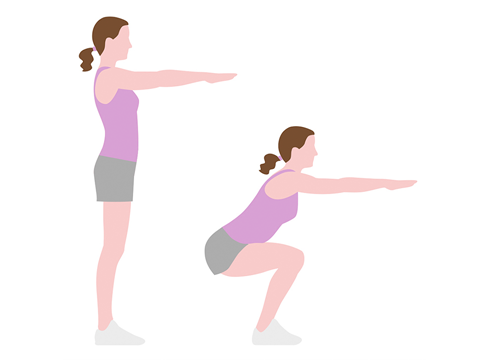3 Reasons Why Squats Are Great For Diabetics By David Andrews

Today I want to go over a short list of three reasons why you need to be squatting in your workout program. If you are currently doing a regular workout (and kudos to you if you are!) but are not doing this exercise, it’s time that you started adding it in.
And, if you are currently not doing a workout at all, well, that needs to change as well. It’s time to get with the program and realize that exercise is one of the absolute best ways to manage your diabetes.
So getting back to squats. What makes them so special? How come they are the move to do when you want to see optimal results?
Let’s look at three primary reasons you want to be ensuring you add squats into the picture.
Reason 1: Squats Build Mega Muscle Mass
First, of all the exercises that you could do in the gym, squats are going to work the most muscle fibers total. Every time you squat, you’ll be hitting your squads, hamstrings, glutes, spinal column muscles, core, and even the upper body to some degree. Few exercises can say they work this many muscles.
Because they stimulate so many muscle fibers, this also means they’ll help you burn more calories overall during the entire workout session. This helps you increase your overall rate of fat loss results, thus managing your diabetes better.
Additionally, because squats will help you build muscle mass so well, that also makes them a great option for permanently increasing your calorie burn. The more lean muscle mass you have, the more total calories you burn each and every day at rest.
Reason 2: Squats Burn Off Glucose
Another great thing about doing squats is because the exercise is so intense, it’s going to burn off a great deal of glucose as well. The more muscle fibers being called into play in any given exercise and the more intense it is, the more energy you’ll need to complete it.
So if your blood sugar levels are currently on the slightly high side, a few sets of squats will get them under control.
This makes squats an excellent damage control exercise for after you know you’ve had a few too many carbs. If you indulge in one meal, plan a workout for afterward and use that energy to help you get through the squat exercise.
Reason 3: Squats Increase Insulin Sensitivity
Finally, because squats will help you increase your total amount of lean muscle mass, this can also help to increase your overall insulin sensitivity rate. The more lean muscle mass you have, the more ‘storage’ your body has to place glucose in when you consume it.
The large leg muscles serve as a huge storage house for glycogen (which is the storage form of glucose in the muscle cell), which will then be depleted during your next workout session.
So for all of these reasons, make sure that you aren’t overlooking squats in your workout any longer. Start slow – if you have to begin with bodyweight squats, that’s fine. Just build up from there as you start to become more and more confident.
To get you started, check out this lower body workout that includes squats in the picture.
Squats – 1 set of bodyweight squats, 3 sets of working squats doing 8 reps/set
Walking Lunges – 3 sets of 10-12 reps/leg
Leg Extensions – 4 sets of 15-20 reps
Hamstring Curls – 4 sets of 15-20 reps
Calve Raises – 4 sets of 15-20 reps
Also on Instagram: https://www.instagram.com/healthawareness7/
good informative post
Downvoting a post can decrease pending rewards and make it less visible. Common reasons:
Submit
Very informative info! Im diabetes free but am gonna start this up to help keep it that way! Thank you for posting!
Downvoting a post can decrease pending rewards and make it less visible. Common reasons:
Submit